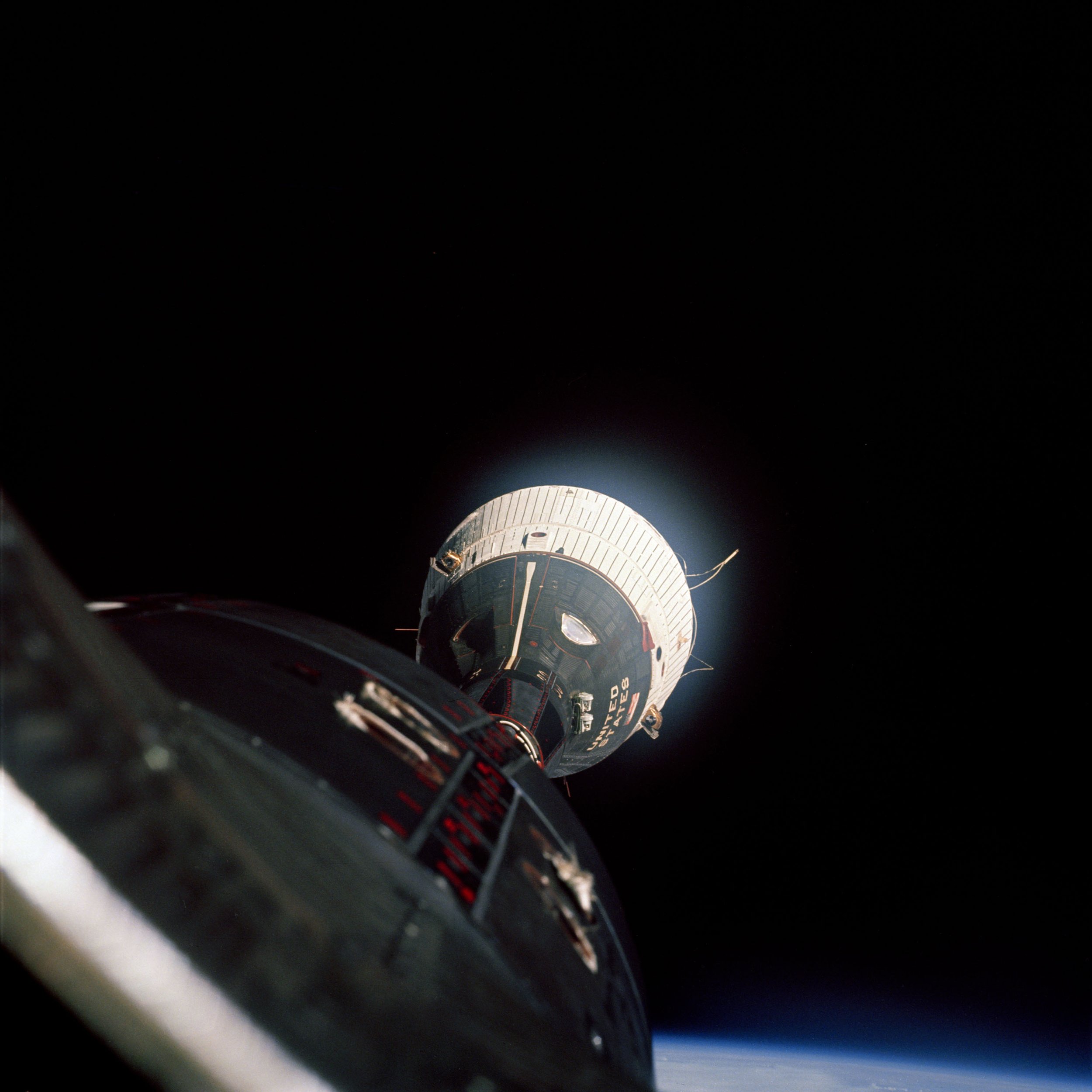
A Doorway to the Moon
View of the Gemini 7 spacecraft as seen from the Gemini 6 spacecraft on December 15, 1965. Image: NASA
First, the astronauts had to prove they could meet up with another spacecraft in space. Known as rendezvous, this maneuver was necessary for the astronauts on the Moon to meet up with the orbiting spacecraft to make the trip home.
Second, and along similar lines, after rendezvousing with the orbiting spacecraft, astronauts also had to dock the lunar module with the command module in order for the Moon crew to transfer into the command module to head back to Earth.
NASA also had several concerns about long duration spaceflight the Gemini program helped overcome. A very brief Moon mission would still take more than a week. During the Gemini program, astronauts were asked to prove they could survive in space for much longer missions, both physically and mentally. Astronauts also performed extravehicular activity, or EVA, to prove they could perform tasks outside the craft. All these skills were tested during the Gemini program.
“I’m coming back in…and it’s the saddest moment of my life.”
— Ed White expresses his sorrow at the conclusion of the first American spacewalk during the Gemini 4 mission on 3 June 1965.
Rendezvous and Docking
The Agena Target Docking vehicle seen from the Gemini 8 spacecraft just prior to docking, March 16, 1966. Image: NASA
One of the most important goals of Project Gemini was for two spacecraft to meet up in space and join safely. These maneuvers were known as rendezvous and docking and were a lot easier said than done!
Gemini 6A and Gemini 7 became the first two spacecraft to rendezvous in space on December 15, 1965. However, the two spacecraft were not equipped to dock; therefore, to practice docking, NASA launched several Agena target vehicles in 1963 and 1964. These unmanned craft were designed specifically to test a manned spacecraft’s ability to rendezvous and dock with another craft. In March 1966, Gemini 8 successfully rendezvoused and docked with an Agena target vehicle.
“Gemini was about the size of a Volkswagen Beetle.”
— Michael Collins, Gemini 10 astronaut
Long Duration Spaceflight
Thomas P. Stafford, Gemini 9 command pilot, inside the spacecraft, June 5, 1966. Image credit: NASA
Astronaut Michael Collins is photographed inside the spacecraft during the Gemini 10 mission, July 18, 1966. Image credit: NASA
Another important objective was to find out if human beings could coexist harmoniously in confined spaces and what were the effects of longer spaceflights. Granted, these pilots were proven professionals, but still the question remained: how would they be after ten days or two weeks of togetherness in space?
The answer was, in short, fine. The astronauts aboard Gemini 7 endured the longest flight of the Gemini program and proved that humans can survive in space for long periods of time. They spent 14 days doing everything together in a space about the size of a car’s front seat. While they learned practical things about living in space, such as the best place to put their trash (behind the seat!), and how to deal with boredom (bring a book!), they also proved that the human body could withstand the long flight necessary to make it to the Moon.
Physically, telemetry monitored much of their bodily functions and did indicate some slowdown in metabolism and a decrease in muscle tone, but nothing that couldn’t be remedied with some basic exercises designed for small spaces
Interpersonally, the astronauts reported an occasional tense moment, but little that would cause concern. In their post-flight evaluation, no significant cognitive deterioration was noted.
“It’s crowded, true enough.
You’re shoulder to shoulder.”
— Gemini 11 astronaut, Richard Gordon
EVAs
Gemini 4 Astronaut Ed White during an Extravehicular Activity (EVA) over the Texas Coast, June 3, 1965. Image credit: NASA
Gemini 12 pilot Edwin E. "Buzz" Aldrin, Jr. during an Extravehicular Activity, November 12, 1966. Image credit: NASA
Before Gemini 4, no American astronaut had experienced time outside the spacecraft. NASA needed to know how astronauts would function outside the protective shell of their spacecraft.
On June 3, 1965, astronaut Edward H. White II opened a bulky hatch and entered space while attached to his craft by a twenty-five-foot umbilical cable. White’s twenty-one-minute excursion proved U.S. astronauts would have the ability to use EVAs to connect to other craft, repair equipment, deploy communications gear and execute other jobs outside the spacecraft.
Video of the Gemini 4 launch and Astronaut Edward White's space walk, June 3, 1965. Video credit: NASA
Problems still cropped up, though, as astronaut Eugene Cernan soon found out on Gemini 9A. Originally, Cernan was supposed to maneuver to the back of the craft, don an Astronaut Maneuvering Unit (AMU), and move around independent of the craft with his very own rocket pack. He even had special, silver pants to protect him from the hot gases that the AMU expelled. But, as he exited the vehicle, Cernan found it nearly impossible to move due to a re-designed, very stiff spacesuit and lack of handholds or footholds. Cernan quickly overheated and fogged up his visor, as his heart raced dangerously from the effort. His fellow astronaut Thomas Stafford helped him get back in the spacecraft where he was reported to be in “excruciating pain.” He lost thirteen pounds on the flight, almost all of it water weight.
Cernan’s near-death experience on Gemini 9A led to a massive revamping of suits and procedures, and the addition of an in-suit cooling system.





